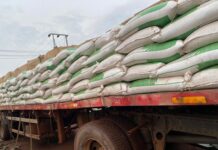ANTANANARIVO – Three consecutive years of drought coupled with a sharp recession triggered by the COVID-19 pandemic will leave a third of the population in Southern Madagascar struggling to put food on the table. With severe malnutrition rates continuing to spiral and many children forced to beg in order to help their families eat, urgent action is required to prevent a humanitarian crisis.
With drought conditions persisting into 2021 and a poor last harvest, weary communities have few resources to fall back on and many have had to leave their homes in search of food and work. Some 1.35 million people are projected to be food insecure – 35% of the region’s population. The figure is nearly double what it was in the same period last year.
The COVID-19 pandemic has added to the hardship, causing seasonal employment to dry up. Many families relied on this income to get through the lean season, which peaks between January and April.
“To survive, families are eating tamarind fruit mixed with clay,” says Moumini Ouedraogo, WFP’s Representative in Madagascar. “We can’t face another year like this. With no rain and a poor harvest, people will face starvation. No one should have to live like this.”
Children are worst affected by the food crisis and most of them have dropped out of schools to beg for food in the streets. A WFP assessment in Amboasary in October 2020 found that three out of four children are absent from school – mostly to help their parents forage for food.
The prevalence of Global Acute Malnutrition (GAM) in children under 5 in the three most affected regions (Androy, Anôsy, and Atsimo Andrefana) stands at 10.7%. This is the second-highest rate in the East and Southern Africa region. The most recent projections put the number of children likely to suffer from acute malnutrition at more than 135,000, with more than 27,000 of these being classified as severe.
WFP currently provides food assistance for almost 500,000 severely food-insecure people in the nine hardest-hit districts in the South. Given the rapidly deteriorating situation, by June 2021, WFP intends to scale up its assistance to reach almost 900,000 of those most vulnerable. However, support will be needed for struggling families well beyond the current lean season.
WFP urgently needs US$35 million to fund lifesaving food and cash distributions and malnutrition treatment programmes. This also includes emergency school feeding for 150,000 children to ensure they can stay in school and build a more secure future.
The United Nations World Food Programme is the 2020 Nobel Peace Prize Laureate. We are the world’s largest humanitarian organization, saving lives in emergencies and using food assistance to build a pathway to peace, stability, and prosperity for people recovering from conflict, disasters, and the impact of climate change.
Source: wfp.org








